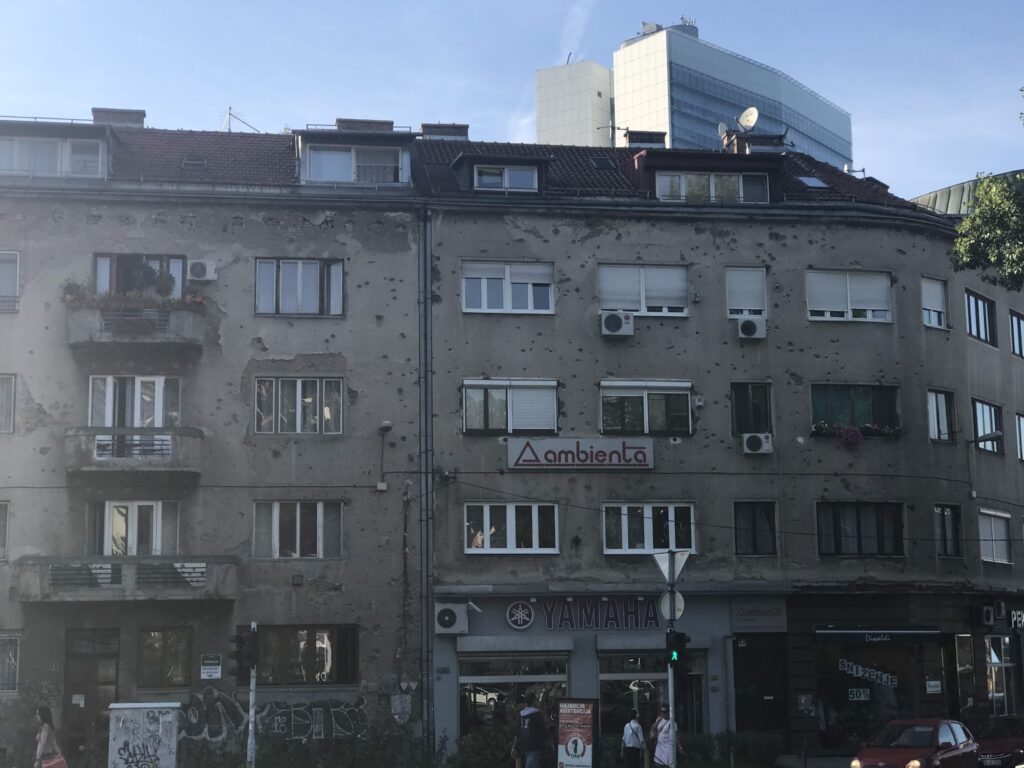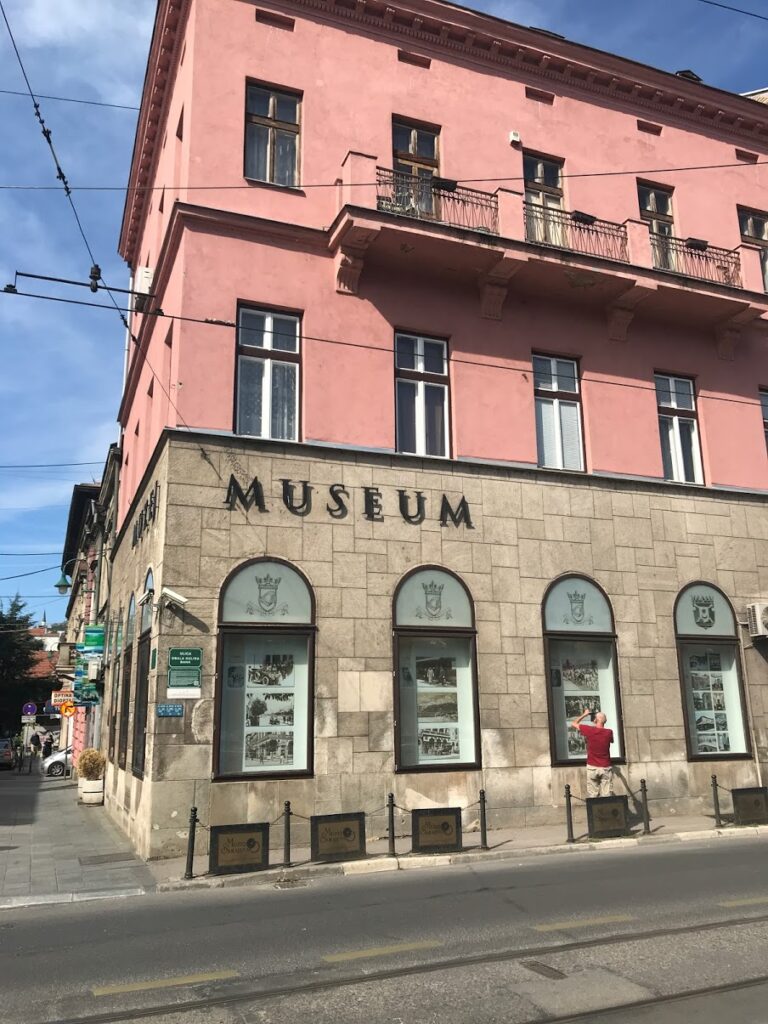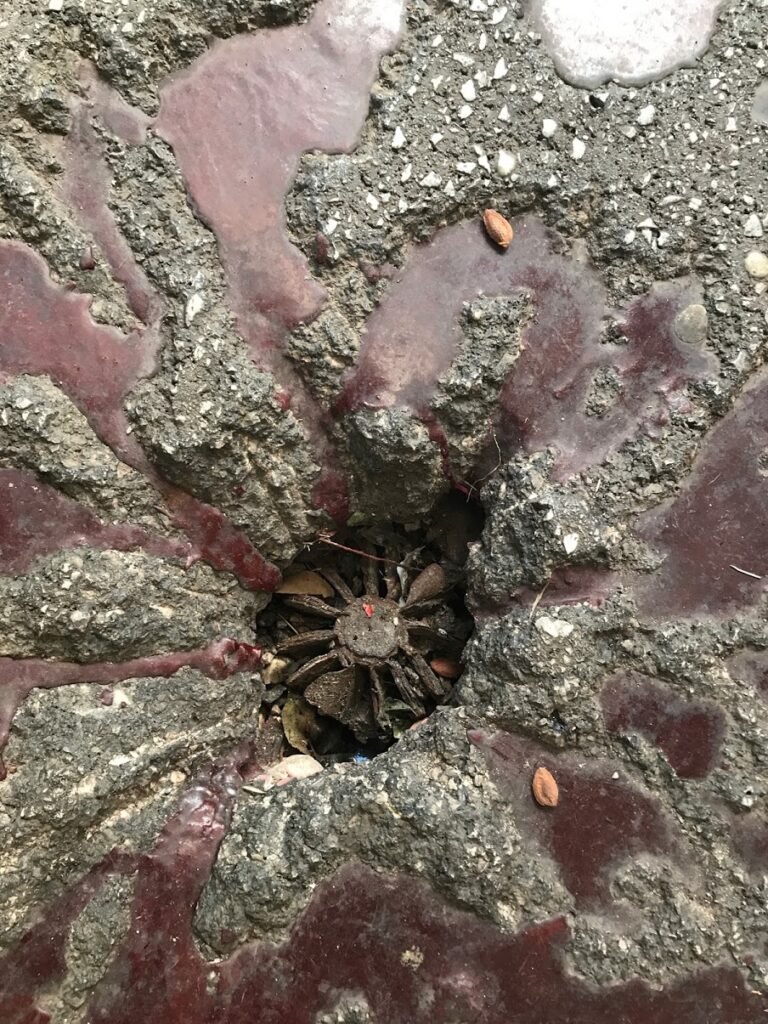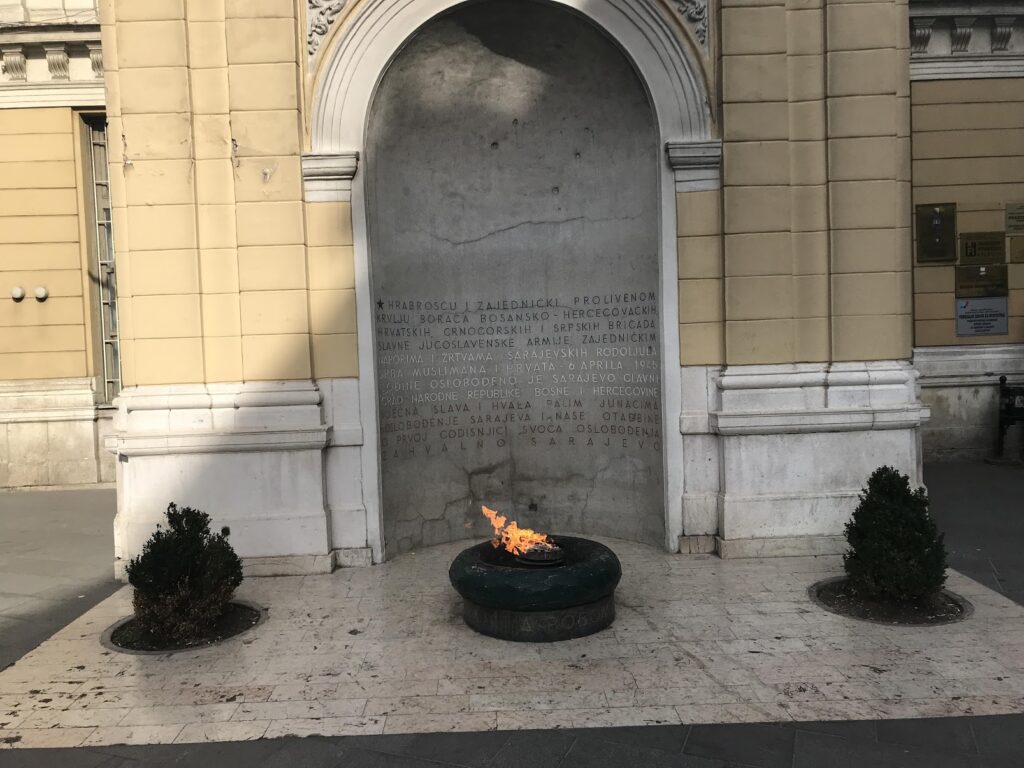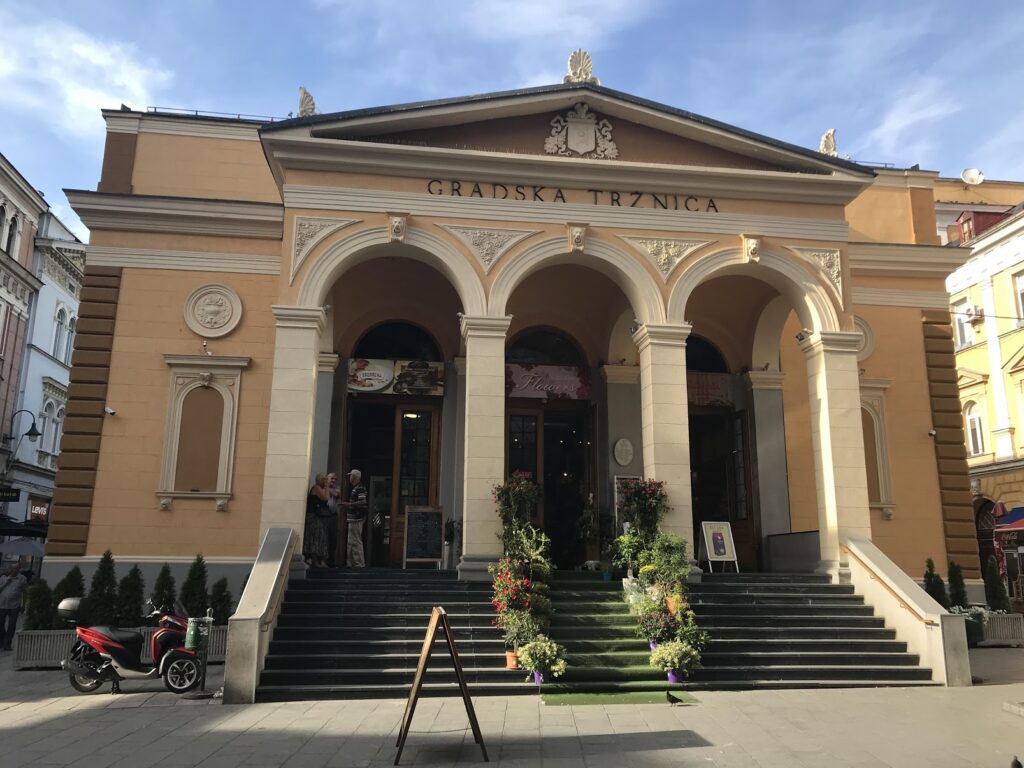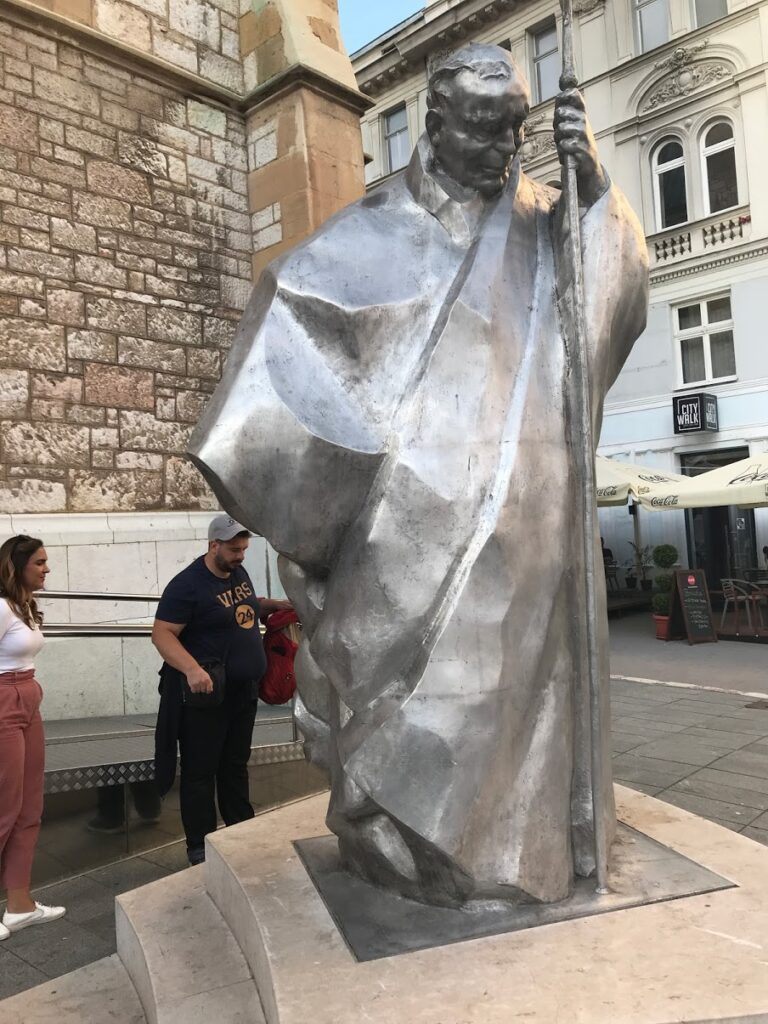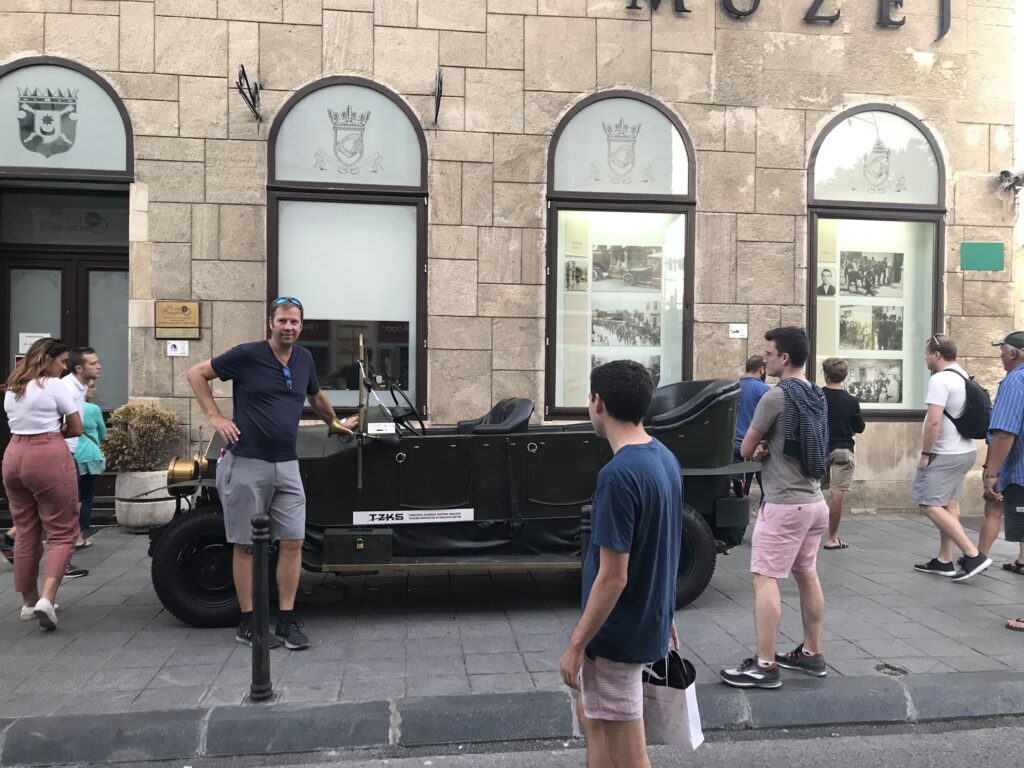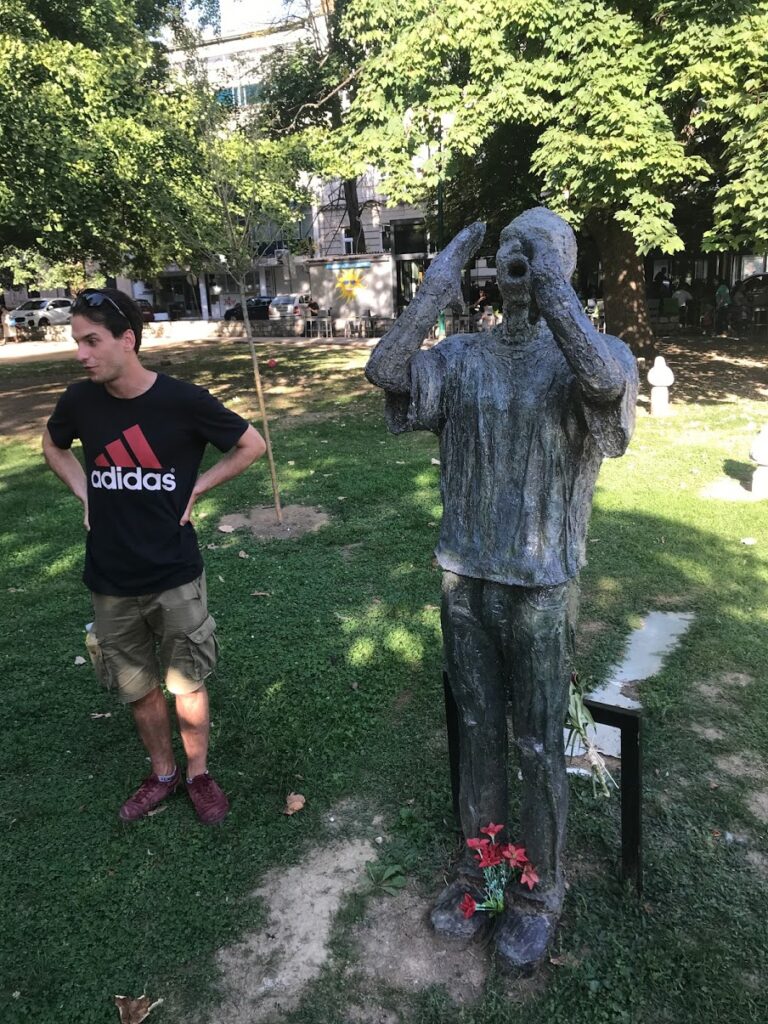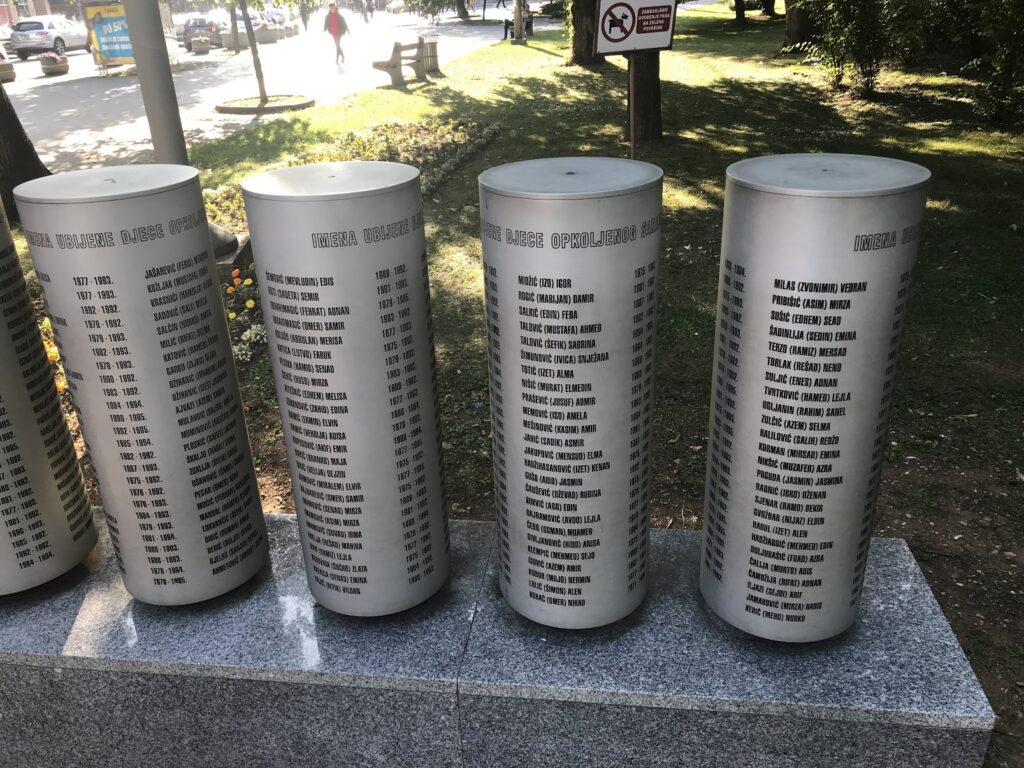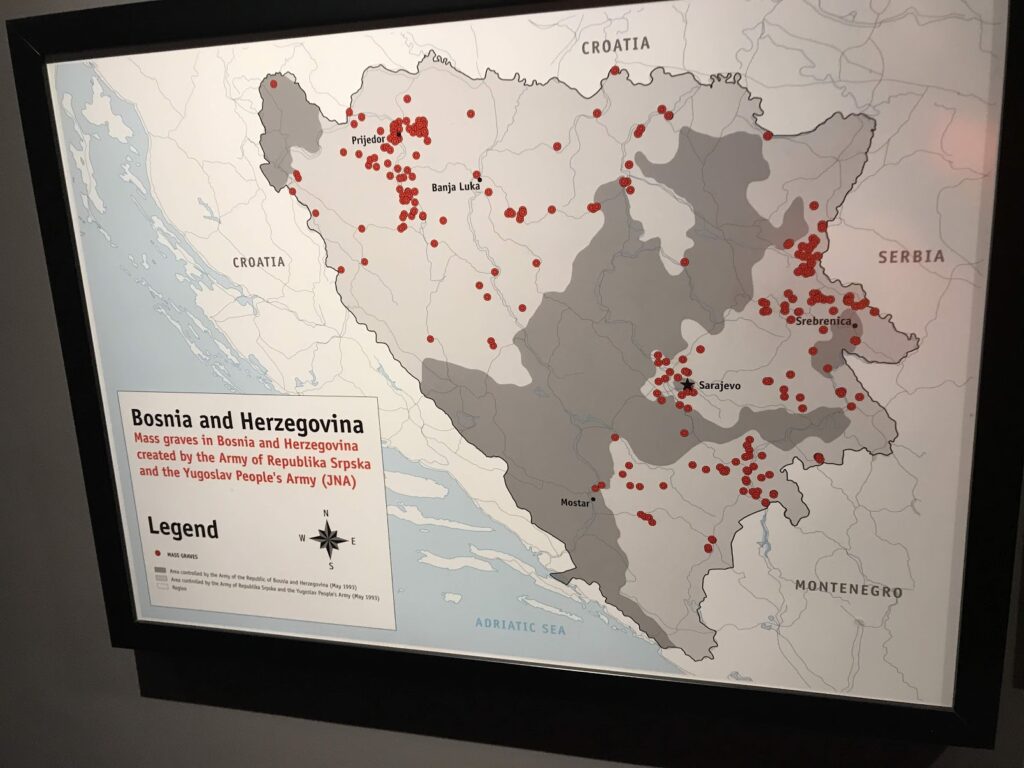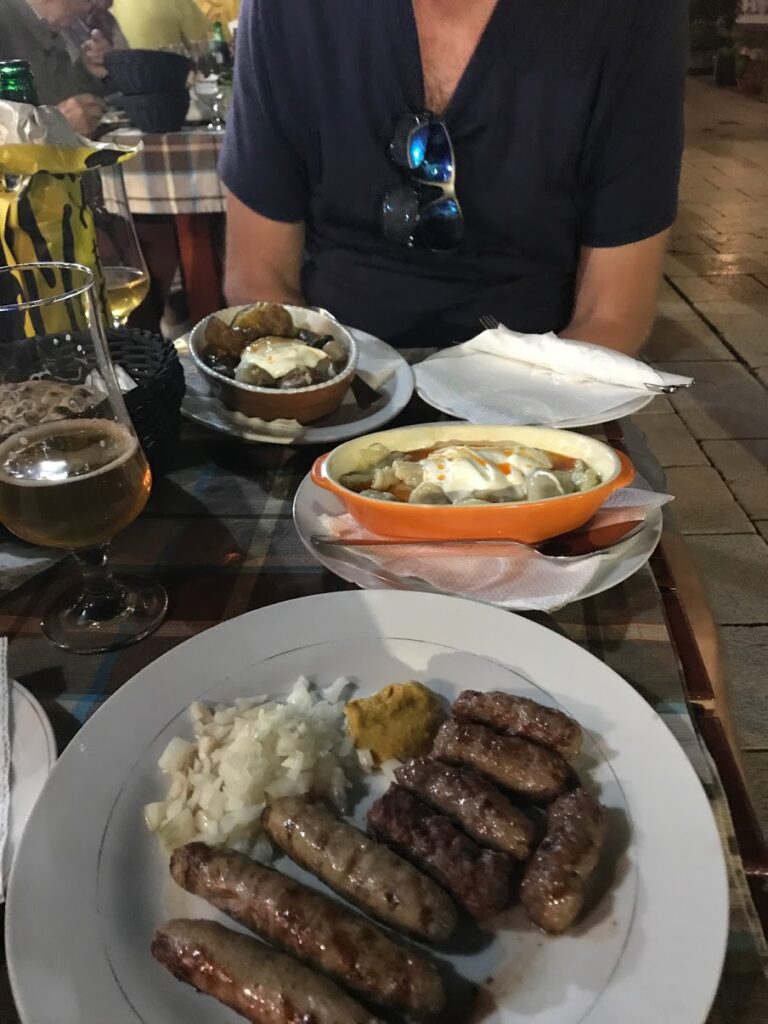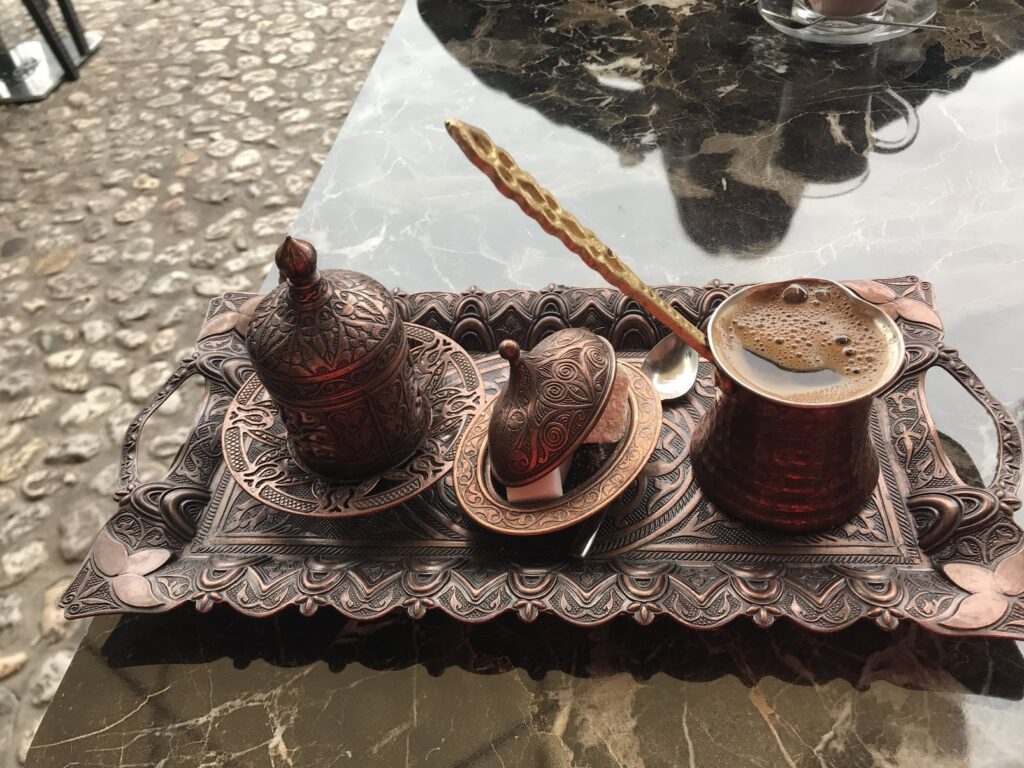After Belgrade, we took a bus to Sarajevo, Bosnia and Herzegovina. This was stop two in the Balkans and in the former Yugoslavia. It was also the one we were most excited about. Of our stops on this trip, Sarajevo is perhaps the most affected by war ‘in our lifetimes.’ I can remember the wars in Yugoslavia between 1991 and 1995 and I can remember the Olympics in Sarajevo in 1984. The bus ride to Sarajevo took about two hours longer than we expected. Crossing borders in the Balkans can be slow going.

Busses from Serbia arrive at the East Sarajevo bus station. East Sarajevo is actually in the west side of the city. And East Sarajevo is actually in the Republic of Srpska. As part of the peace negotiations in 1995, the Bosnian Serbs were given an area in Bosnia as their own under their own control. It is not technically under the control of Bosnia and Herzegovina but is an area that also sliced off a section of Sarajevo.
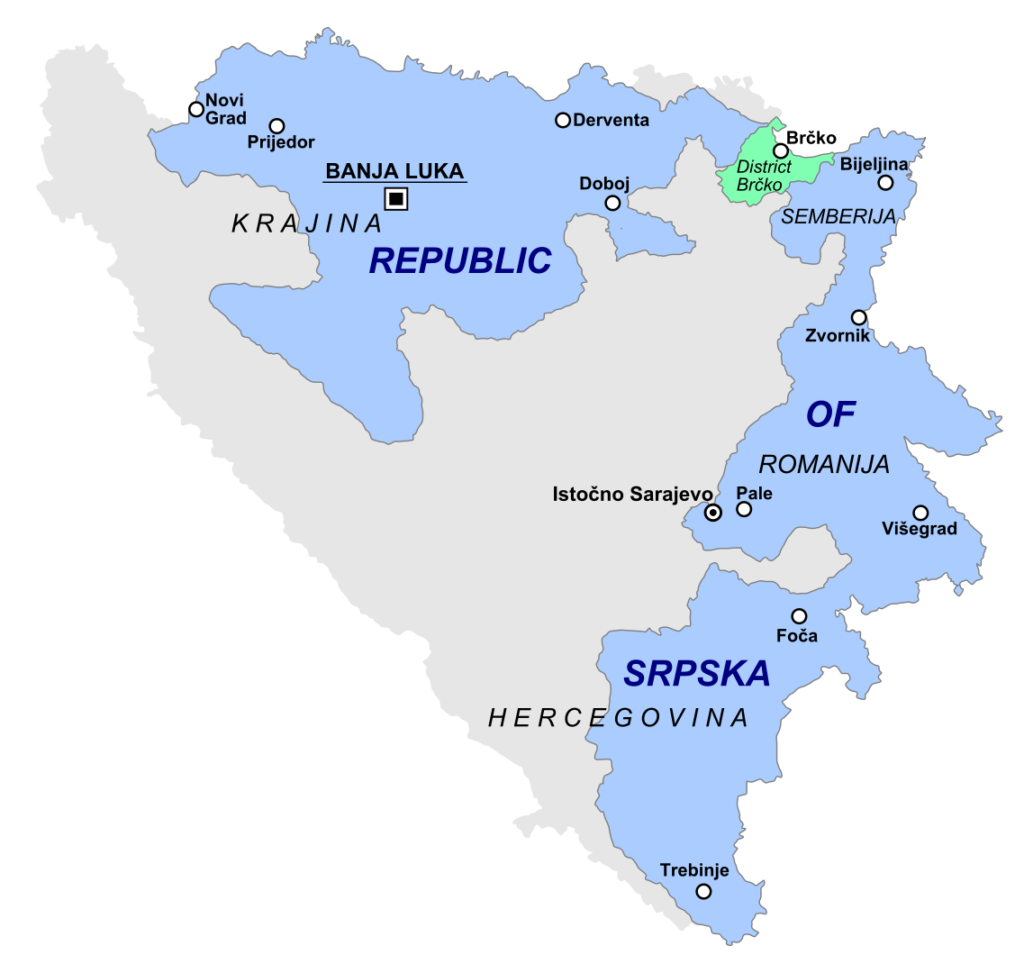
Of the six former republics of Yugoslavia, BiH is the one that is most multicultural with most mixed families of Muslims, Serbs, Croats, etc. I am sure the wars caused much strife for families as mixed families had friends and relatives on both sides.
In Sarajevo, the buildings and streets still show the signs of the battles that were fought here. Bosnian Serbs fired bullets and mortar shells from the hills surrounding Sarajevo. People in Sarajevo were essentially pinned down in their city while the Serbs held the high ground all around them. It was all the Bosnian military could do to just keep the Serbs from entering the city. However, the buildings in Sarajevo still have bullet holes and there are mortar shells still embedded in the ground that they have kept there as a reminder of the war and the civilians that died in the bloody siege of Sarajevo which lasted 1425 days.
Snipers positioned in the hills picked people off as they tried to run to work or to get food. There is an area called sniper alley but frankly the entire periphery of the city would have been a sniper zone. People painted signs warning each other of the snipers who would shoot people down long streets that were a straight shot from the hills. The airport became an important area during the war. The runway was the only thing keeping Bosnians from getting to a free territory away from Sarajevo and safe from the army of the Republic of Srpska. If you tried to run across the runway you would be shot by snipers. So, Bosnians dug a tunnel under the runway that was 800 metres long. This is the way they also got supplies into Sarajevo. Nevertheless, they were still starving in the city. Eventually, the UN declared the airport as a safe zone.
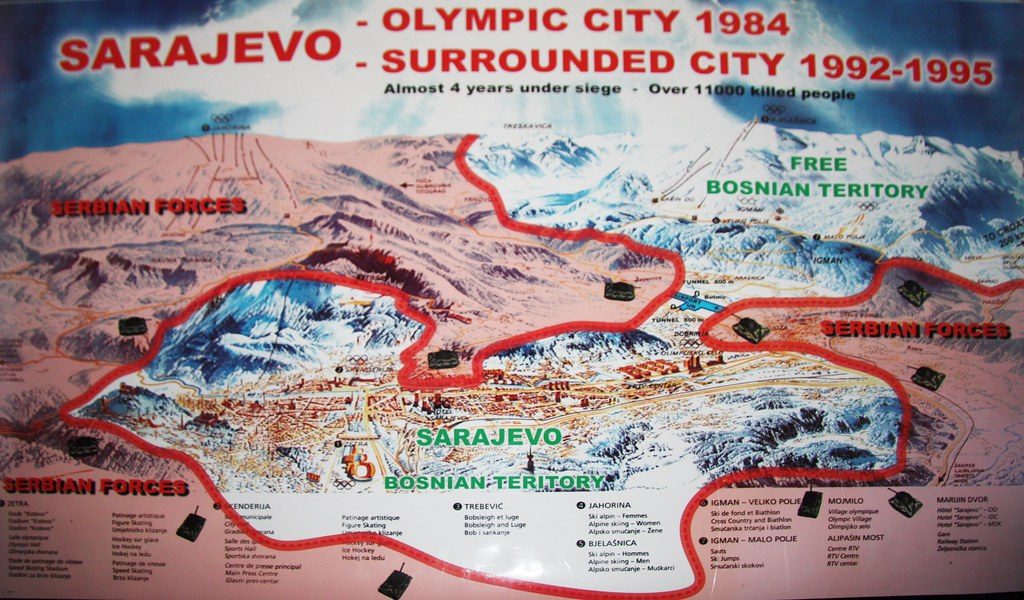
Again, I cannot do justice to the whole story so would encourage everyone to do their own research to get a balanced history. We have done more research but the walking tours are perhaps the most informative thing we have done. We did two in Sarajevo.
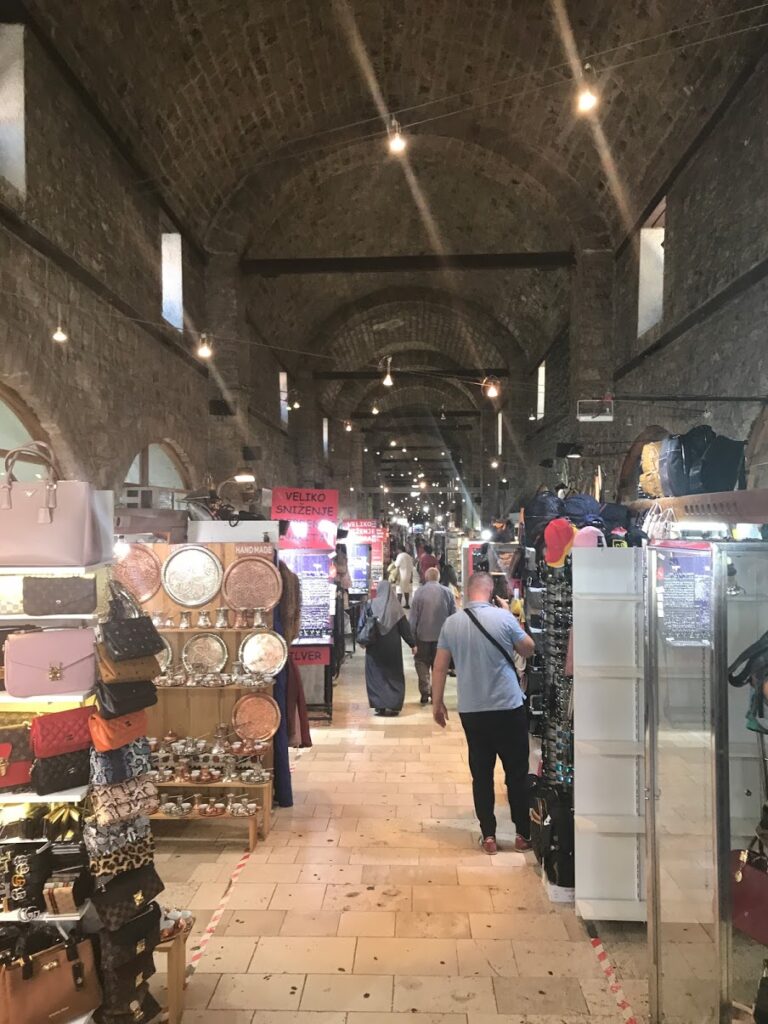
Strolling through a market 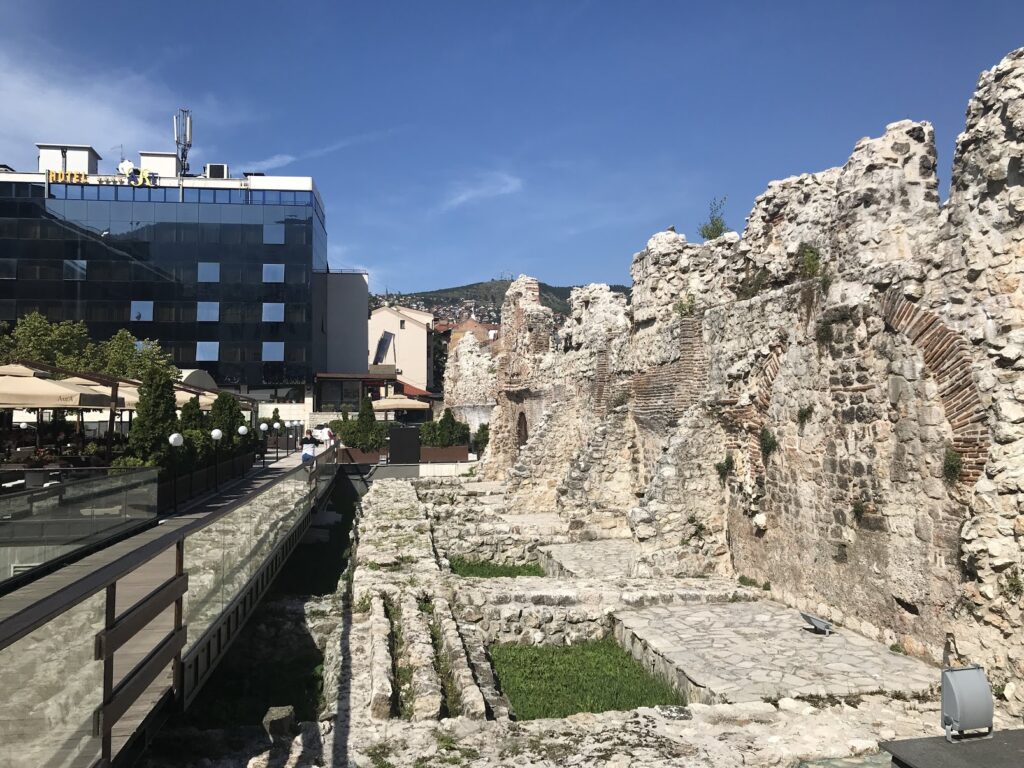
There are remains from Ottoman times 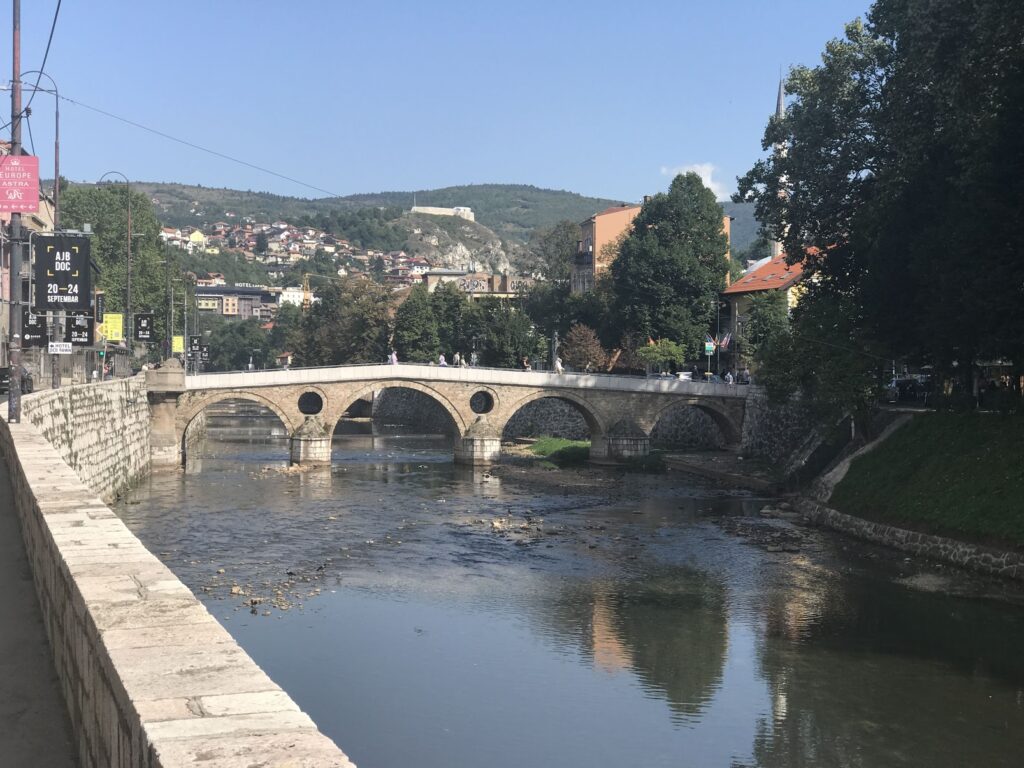
The Miljacka River 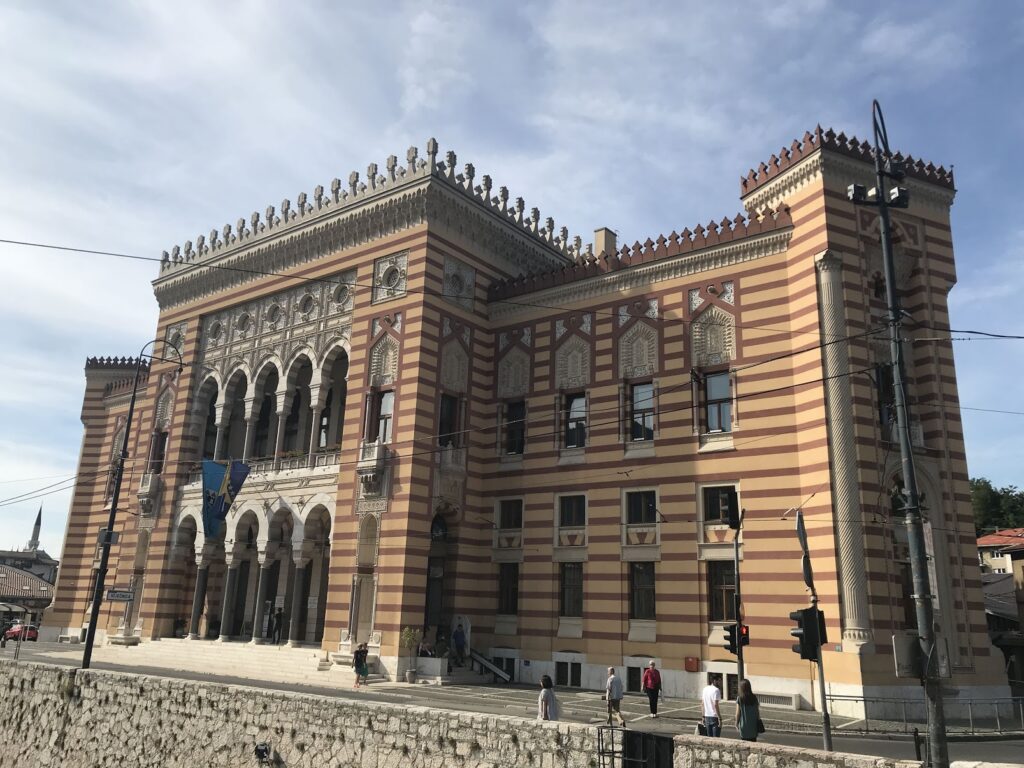
City Hall was completely destroyed in the war 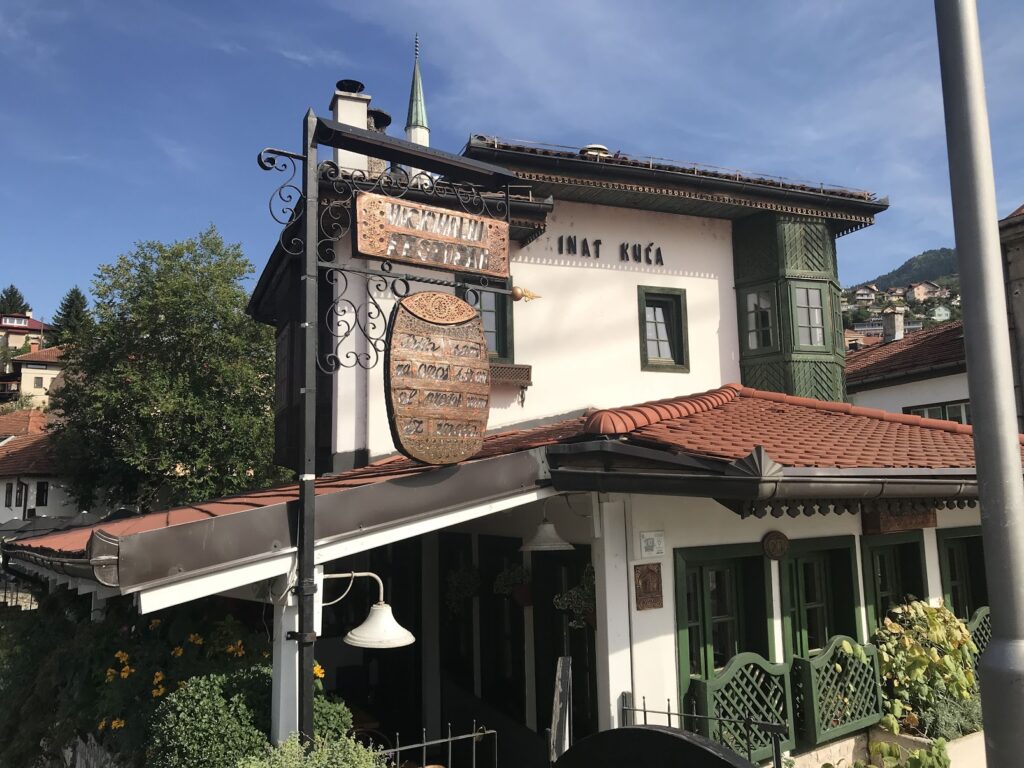
This restaurant is called the House of Spite 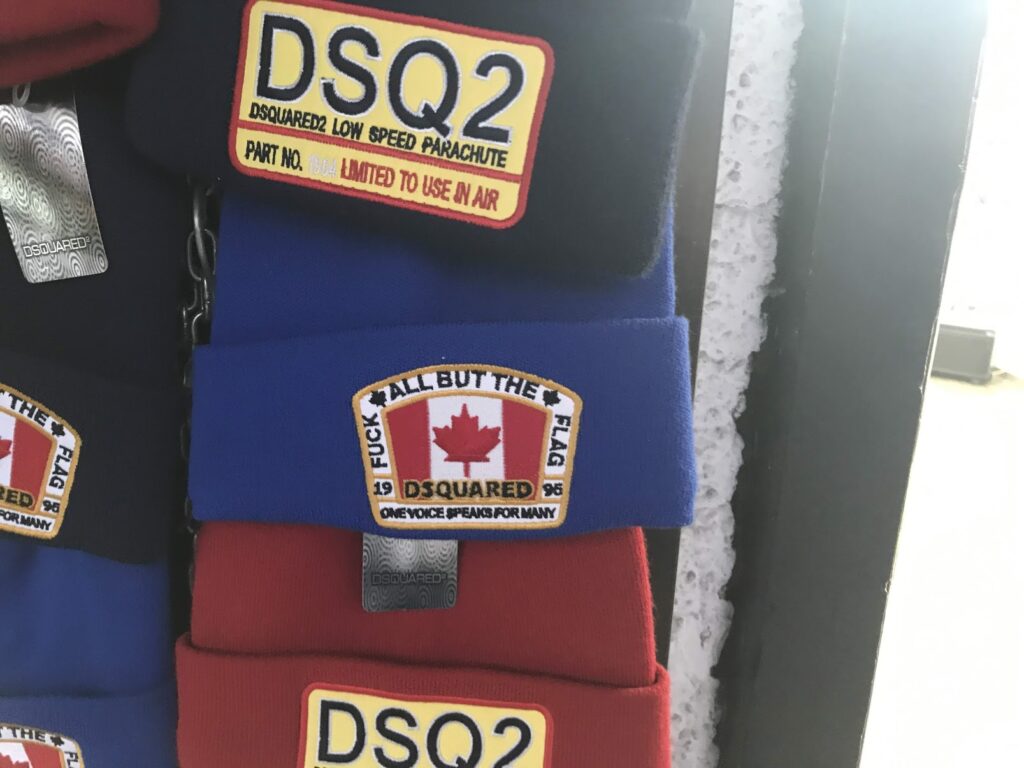
Should this bother Canadians? Or does it mean that they respect our flag? 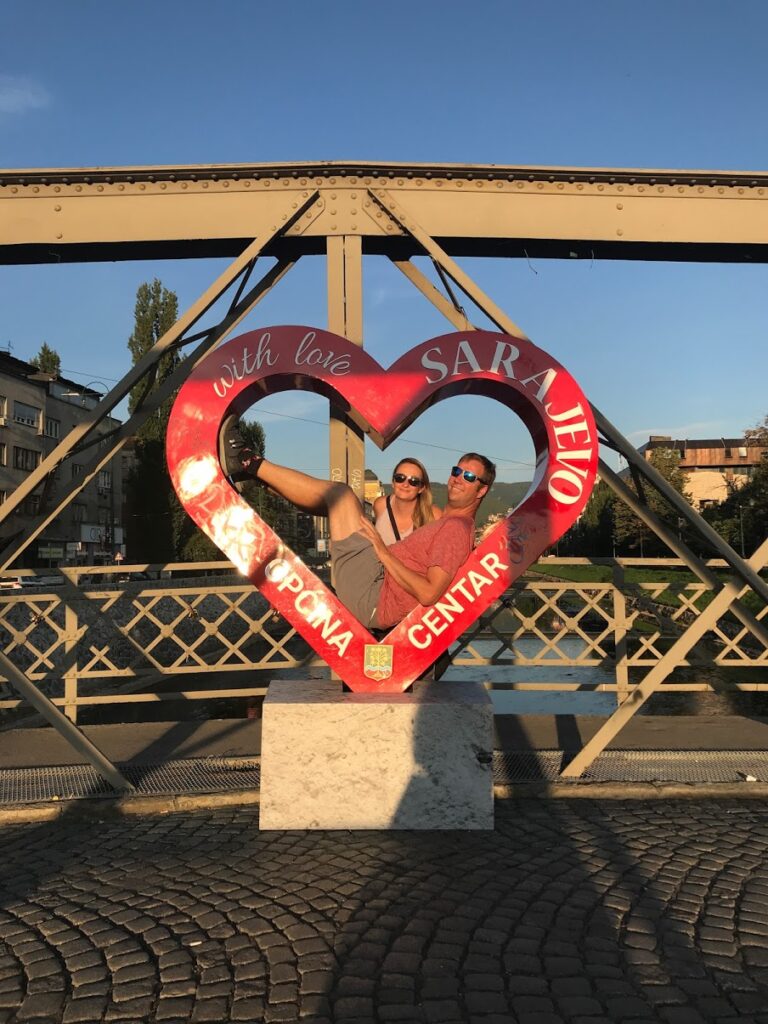
Love from Sarajevo 
This is a college 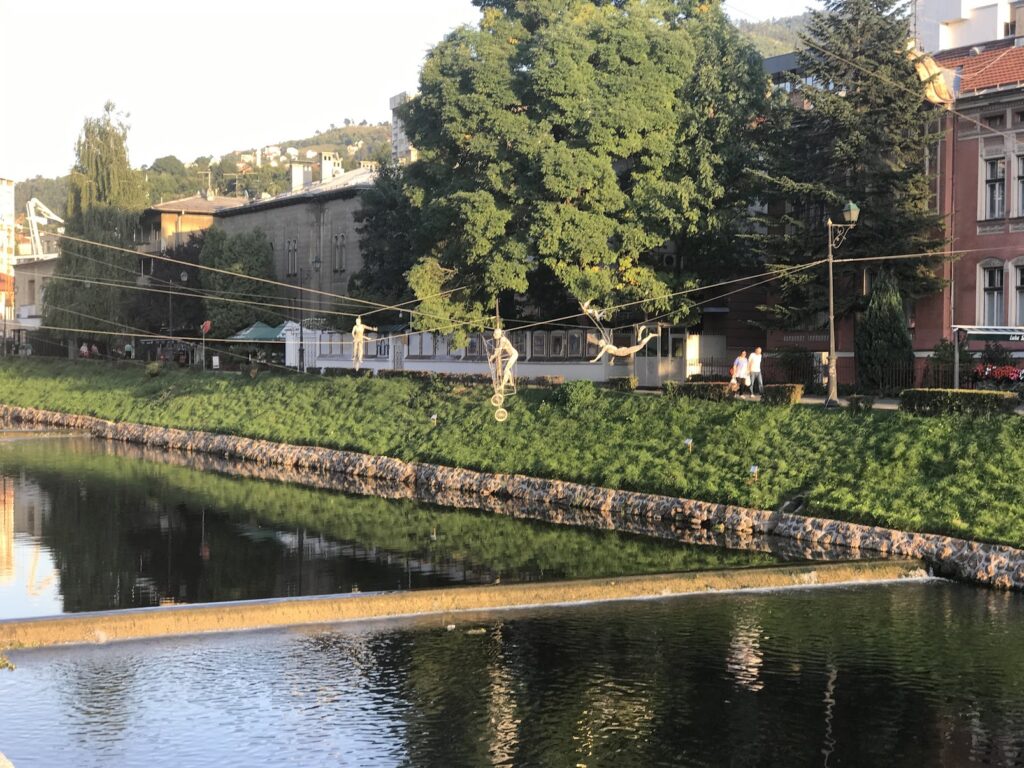
Cool figures over the river 
Playing chess in the park
The first walking tour was with Toorico Tours and Ervin our tour guide. This is Ervin’s own company and he is the #1 tour on TripAdvisor. He only takes a maximum of 8 people but there were six of us. Ervin showed us around the Old Town area of Sarajevo but integrated many stories of the war as well as life today in BiH. Sarajevo has a very neat old town area. At one point there is a marking on the street that indicates where east meets west. If you look east down the street you will get a distinct feel of Turkish/Ottoman architecture. If you look west you will get a feel of western European architecture. There was information about the assassination of Archduke Ferdinand that started World War I as well as information about the 1984 Olympics.
We went through the fruit market which was targeted by a mortar shell and killed 69 people in the market. The mortar shell is still embedded in the pavement in this market which continues to thrive today. Ervin also took us to a sweets shop and gave us free samples of baklava and other sweets. In the fruit market he gave us raspberries (BiH is the greatest producer of raspberries in the world so we were told). In another shop we were given a sample of rose water. If you go to the Galerija 11/07/1995, telling them that you did a tour with Ervin will save you 2 euros on your admission. A tour with Ervin is much more than just a free walking tour. I highly recommend you check it out.
The next day we did a second free walking tour, this time with Tallest Tour Guides. Our guide was Nikola and this was a tour completely focused on the Siege of Sarajevo. It went to several different areas but a few of the same areas. The difference is that this tour completely focused on the chronology and details of the war that was fought in Sarajevo. Unlike the tour in Belgrade, this one was very objective and factually based. I suppose how you present facts can show bias but we did not get the feeling that Nikola was trying to give us his opinions.
The following day, we were on our own and did a few of the things that we felt were left to check out. It was misty and grey but it was still a full day for us. We started by going to the Sarajevo Brewery and going in the museum. It is the smallest and most underwhelming museum we have been into. The best part of it was that for the price we paid we got one beer. After the brewery, we took the cable car up to where the Olympic bob sled track is located. We don’t often pay for cable cars and funiculars, but in this case it is a very long ride but would have been a very long walk uphill in the rain. It was worth 12 euros we paid return… in my opinion. At the top, we walked the abandoned bob sled track. It is painted with graffiti and makes a great place for walks. Apparently, some people who are braver than me like to bomb down it on their mountain bikes. Scary. On the way down, we stopped into a free museum that someone had turned their home into. It was showing how they lived in the hills during the siege. They had turned part of their home into a bunker and had to go to the brewery every day to get water. It was free but by donation.
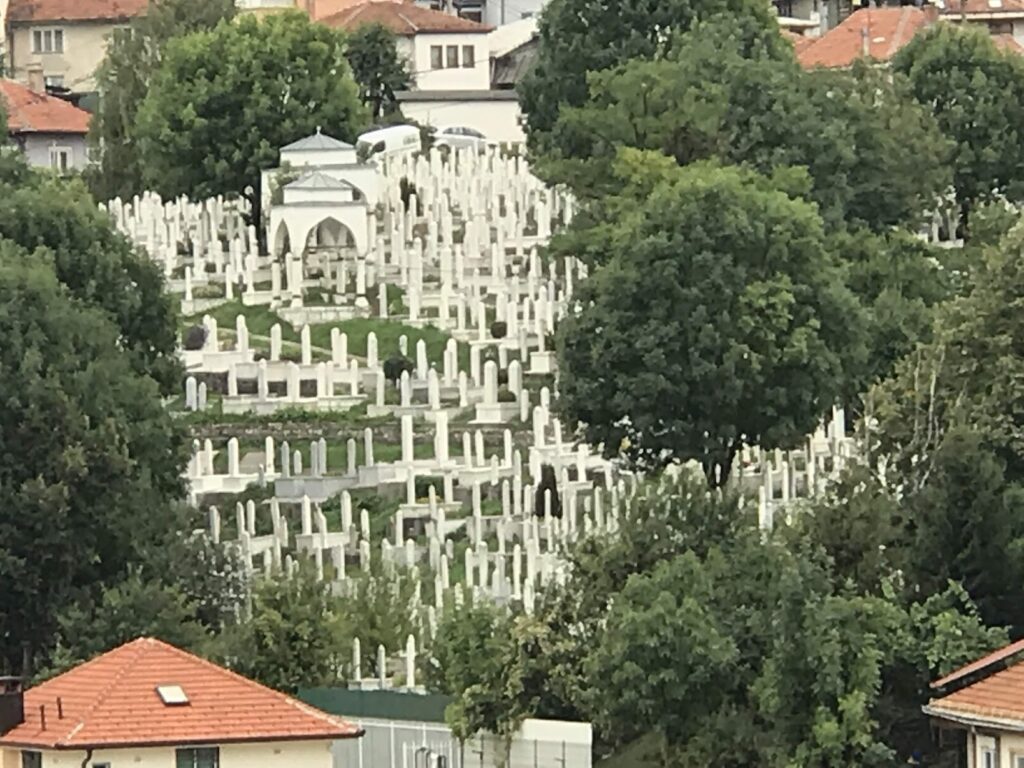
Cemeteries filled with victims of the war 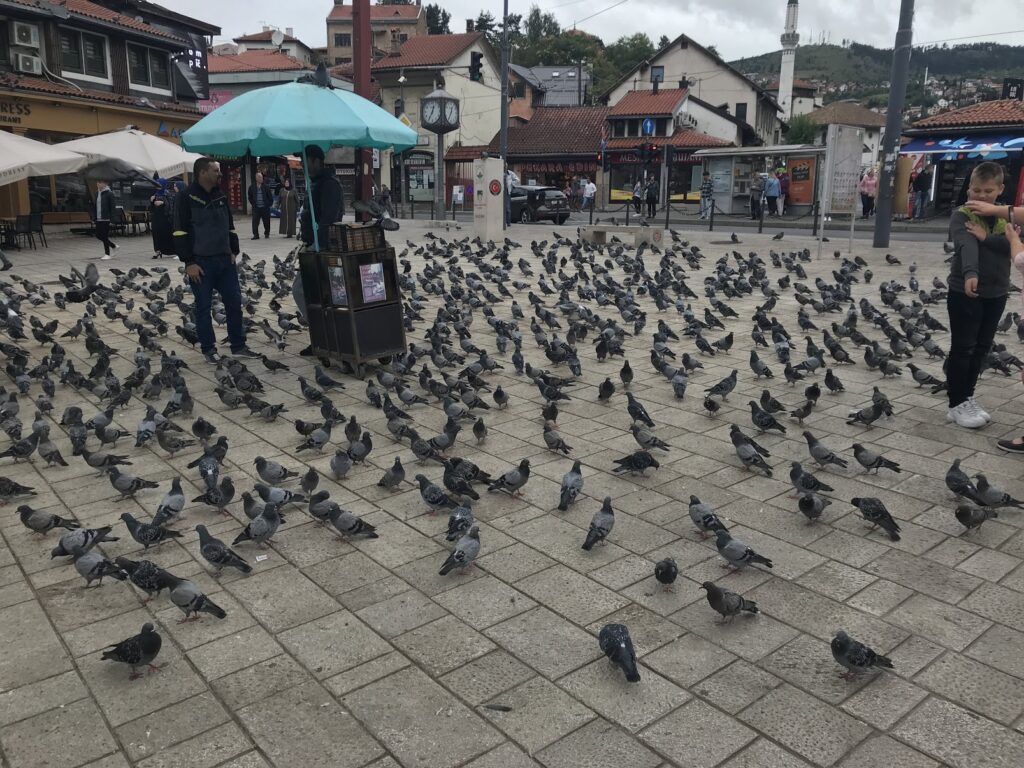
Feed the pigeons? 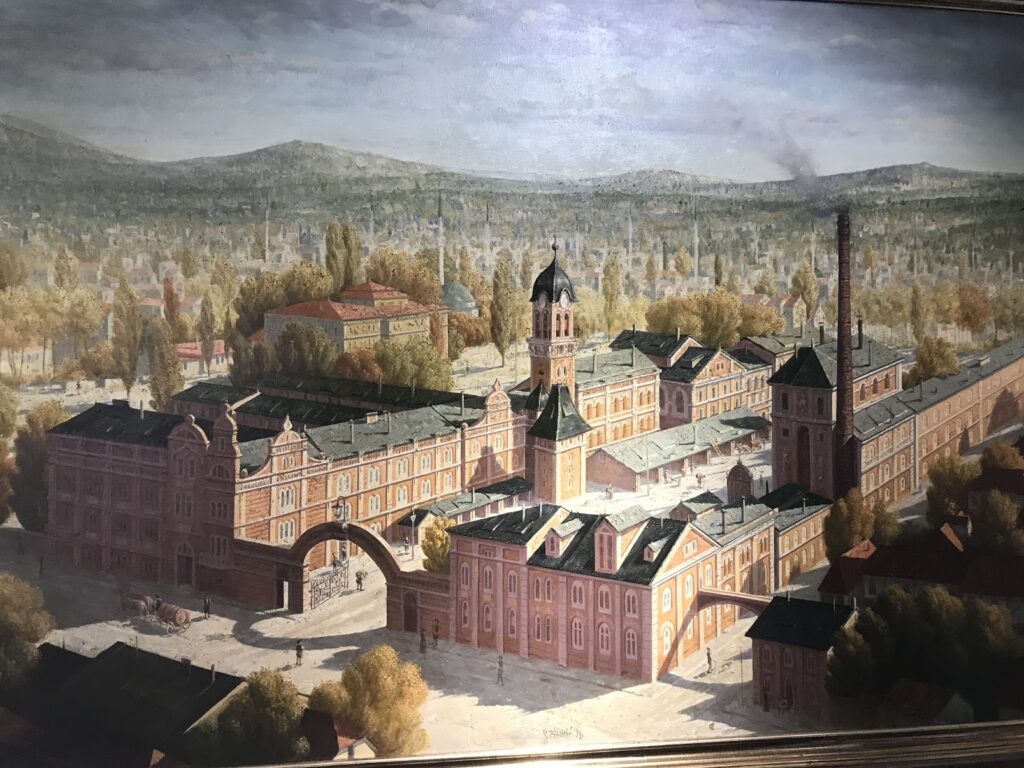
A portrait of the brewery 
Going up the cable car 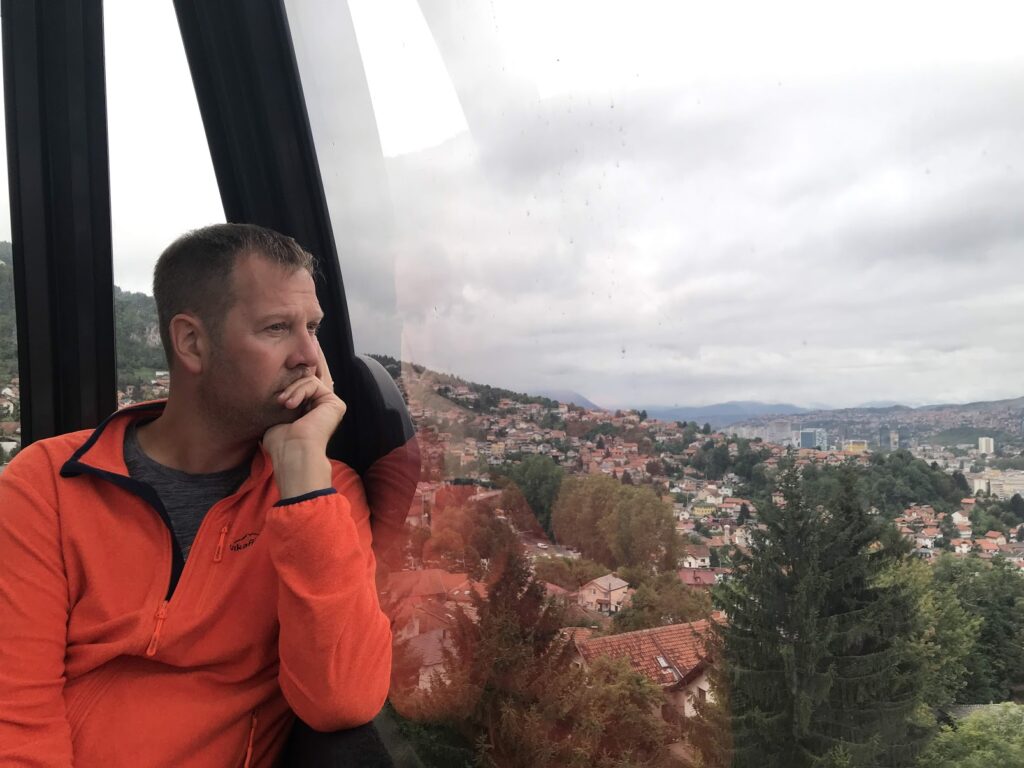
Pondering life 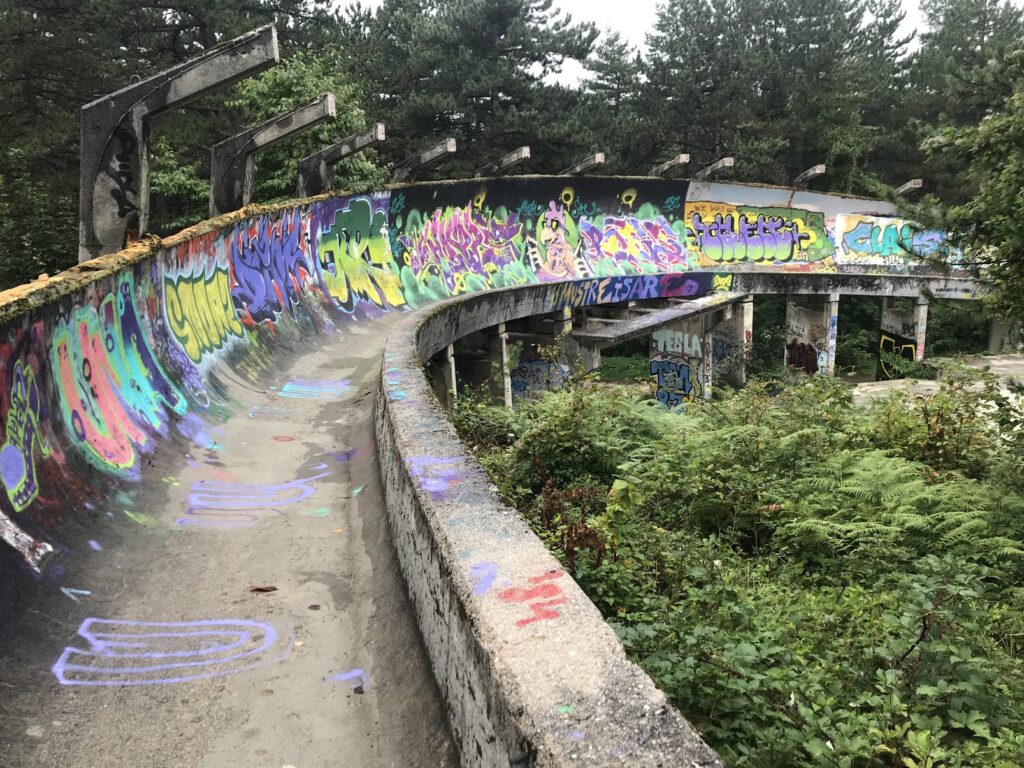
Bob sled track 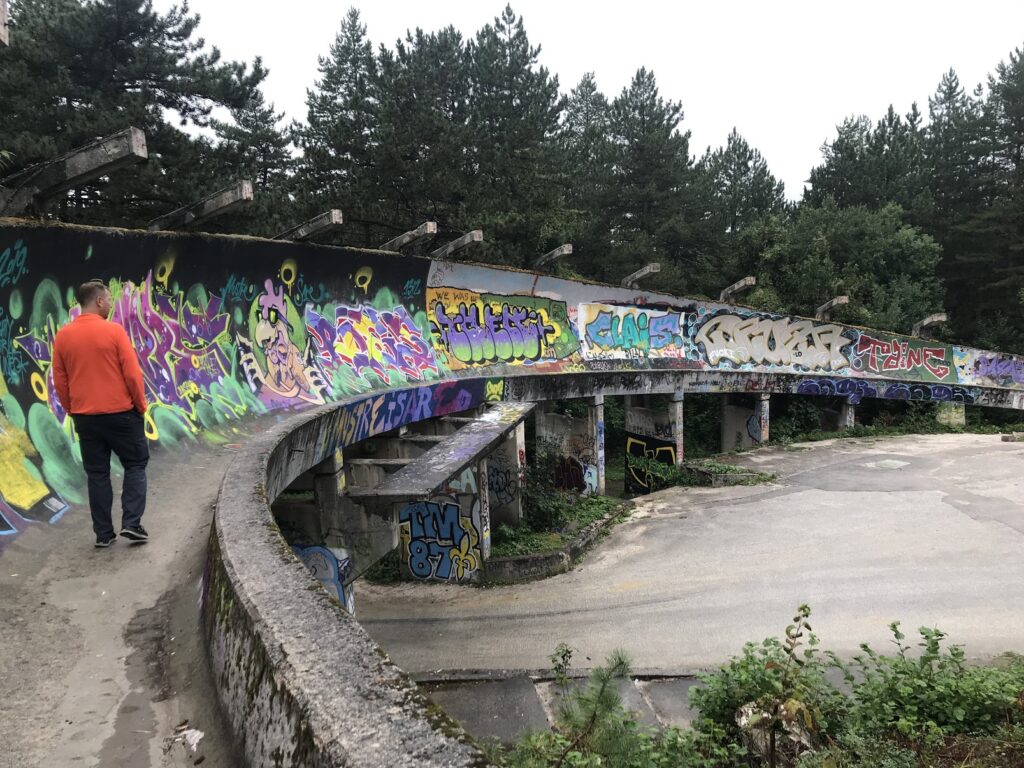
Good for a stroll 
The graffiti is pretty amazing 
A graffiti up close 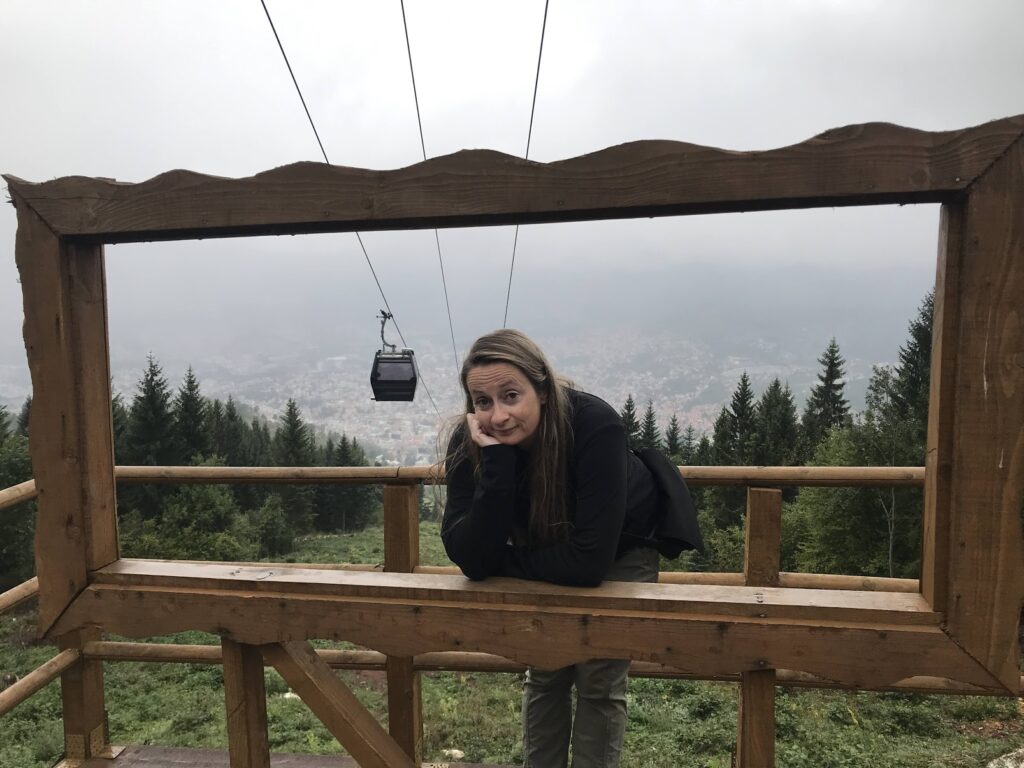
The weather is not great 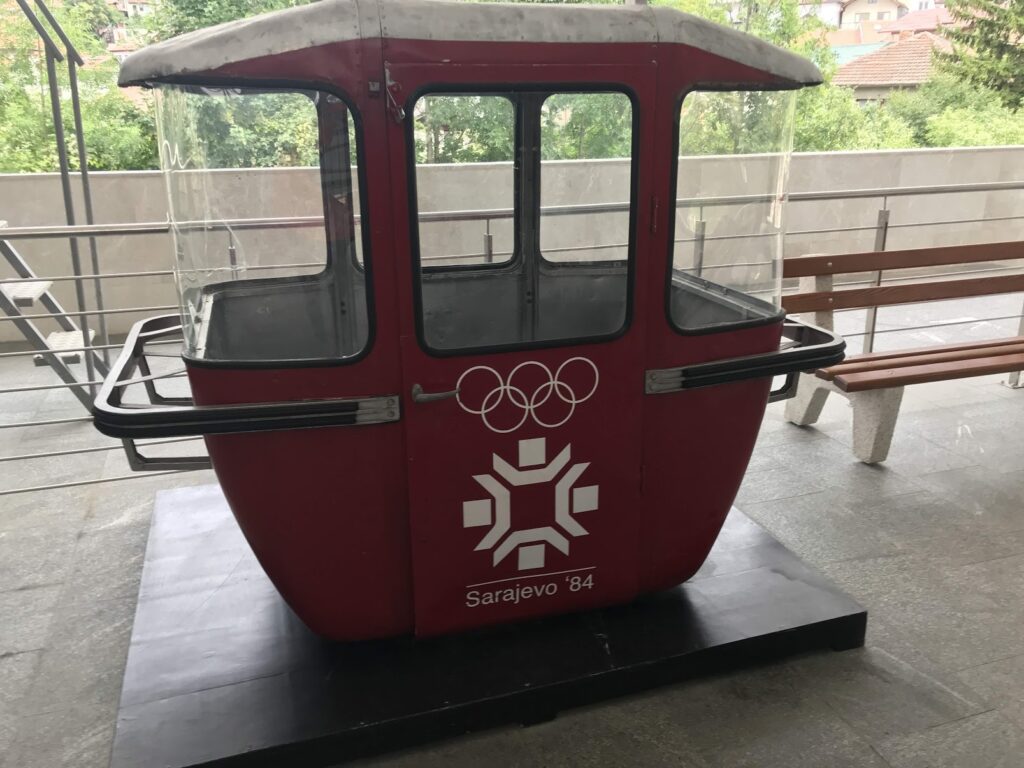
One of the cable cars in 1984 
This free museum was just off the stair to the cable car 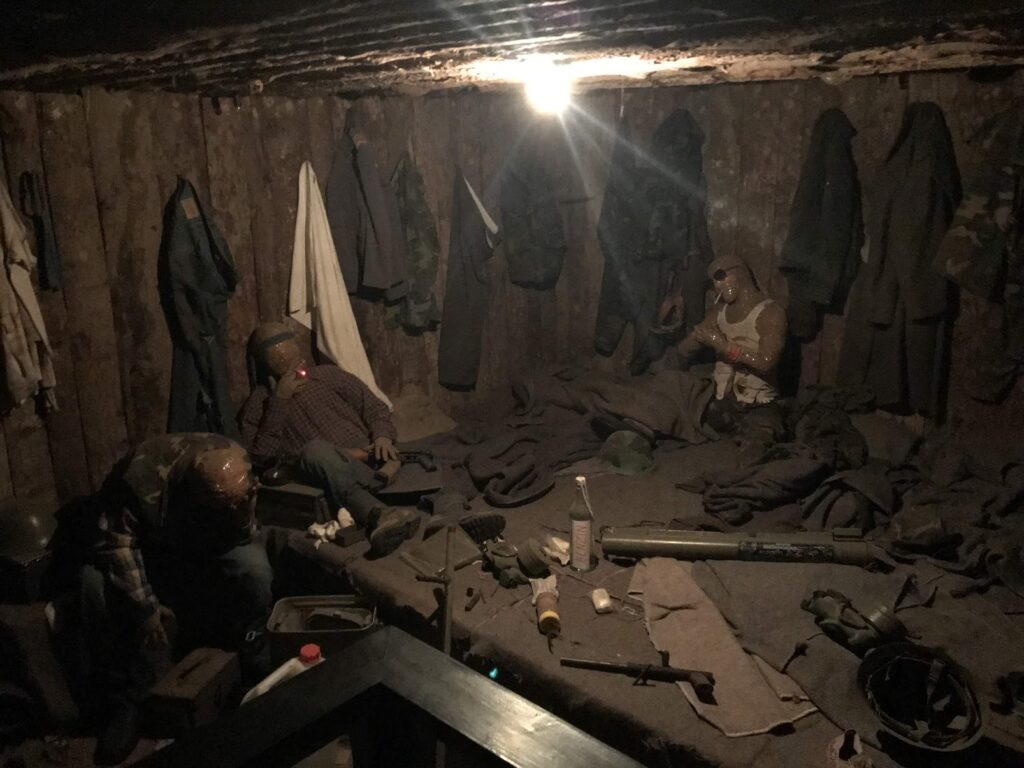
A replica of a bunker 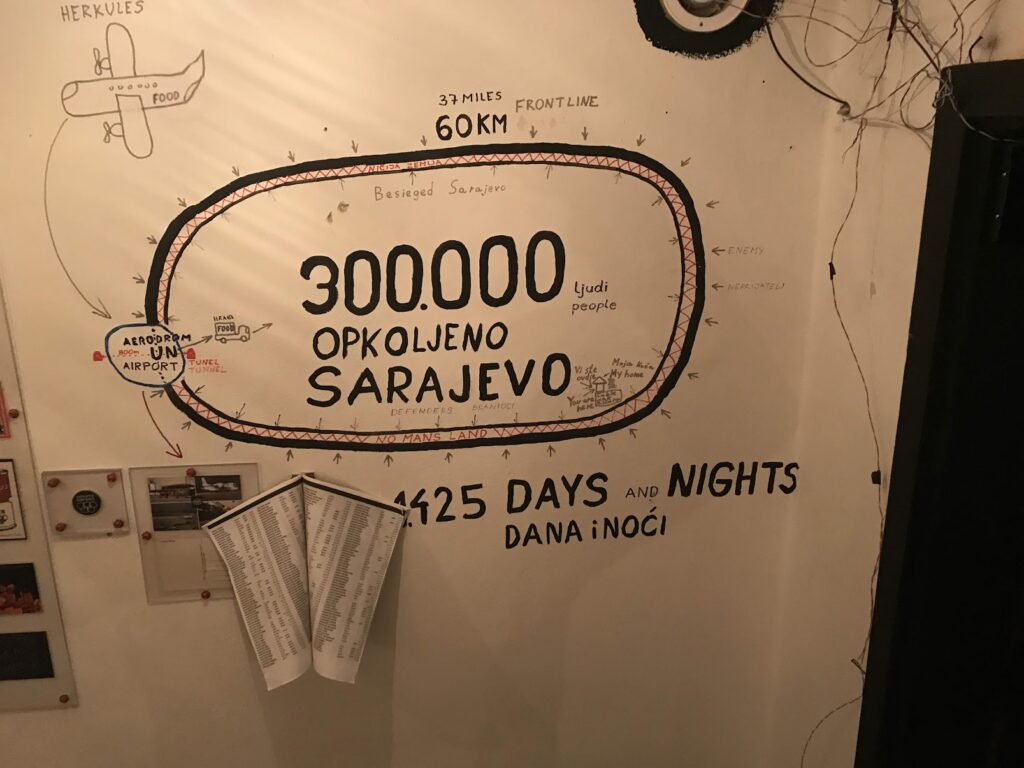
On the wall they have illustrated the siege 
This lasted 1425 days
Finally, we went to the Galerija 11/07/95. This gallery is dedicated to the memory of the massacre that happened in Srebrenica. It is a very heavy subject as it tries to illuminate the genocide of 8372 Bosnians in the town of Srebrenica over about a five day period in July 1995. It is the worst example of genocide since World War II. It is hard to wrap my mind around this as I could not imagine something like this happening less than 25 years ago. There are photographs and videos from during and after the war. We saw one video in which a Bosnian Serb soldier called men one by one to the edge of a pit and shot them in the back. We saw images of the mass graves that have been dug up and continue to be dug up today. We were in there for about 2 hours and could have been there longer… but like I said it was heavy and that was what we could take.
A little about the food we had in Sarajevo. Ervin had sent us some recommendations. One of them we went to a few times. The first time I had Bosnian Pot which is kind of like a soup or stew but it did not have a lot of meat. We went back another day for lasagne because it looked so good. And then another day I had a pizza. One of the things to eat here is cevapi which is sausage fingers in a pita. We did not eat it here but tried it in Zagreb, Croatia. On another night, we went to another place that Ervin had recommended. We sat beside three men who were celebrating the retirement of one of them. We let them order us a traditional meal which consisted of different grilled meats and pierogies. We had a good time with them and one of them asked if we had any Canadian women we could introduce him to. He looked like he was mid 70s but it turns out he was a old looking 57 year old. The other thing to try is Bosnian coffee. It is like Turkish coffee but not quite the same. They use hand crafted copper pots, cups, and trays to serve you a strong coffee. It is quite nice both in appearance and taste.
We moved on from Sarajevo to Zagreb, Croatia. More about that in my next post.



